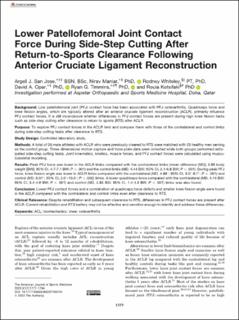| dc.description.abstract | Background: Low patellofemoral joint (PFJ) contact force has been associated with PFJ osteoarthritis. Quadriceps force and knee flexion angles, which are typically altered after an anterior cruciate ligament reconstruction (ACLR), primarily influence PFJ contact forces. It is still inconclusive whether differences in PFJ contact forces are present during high knee flexion tasks such as side-step cutting after clearance to return to sports (RTS) after ACLR.
Purpose: To explore PFJ contact forces in the ACLR limb and compare them with those of the contralateral and control limbs during side-step cutting tasks after clearance to RTS.
Study Design: Controlled laboratory study.
Methods: A total of 26 male athletes with ACLR who were previously cleared to RTS were matched with 23 healthy men serving as the control group. Three-dimensional motion capture and force plate data were collected while both groups performed anticipated side-step cutting tasks. Joint kinematics, kinetics, muscle forces, and PFJ contact forces were calculated using musculoskeletal modeling.
Results: Peak PFJ force was lower in the ACLR limbs compared with the contralateral limbs (mean difference [MD], 5.89 body weight [BW]; 95% CI, 4.7-7.1 BW; P < .001) and the control limbs (MD, 4.44 BW; 95% CI, 2.1-6.8 BW; P < .001). During peak PFJ force, knee flexion angle was lower in ACLR limbs compared with the contralateral (MD, 4.88°; 95% CI, 3.0°-6.7°; P < .001) and control (MD, 6.01°; 95% CI, 2.0°-10.0°; P < .002) limbs. A lower quadriceps force compared with the contralateral (MD, 4.14 BW; 95% CI, 3.4-4.9 BW; P < .001) and control (MD, 2.83 BW; 95% CI, 1.4-4.3 BW; P < .001) limbs was also found.
Conclusion: Lower PFJ contact forces and a combination of quadriceps force deficits and smaller knee flexion angle were found in the ACLR compared with the contralateral and control limbs even after clearance to RTS.
Clinical Relevance: Despite rehabilitation and subsequent clearance to RTS, differences in PFJ contact forces are present after ACLR. Current rehabilitation and RTS battery may not be effective and sensitive enough to identify and address these differences. | en_US |

